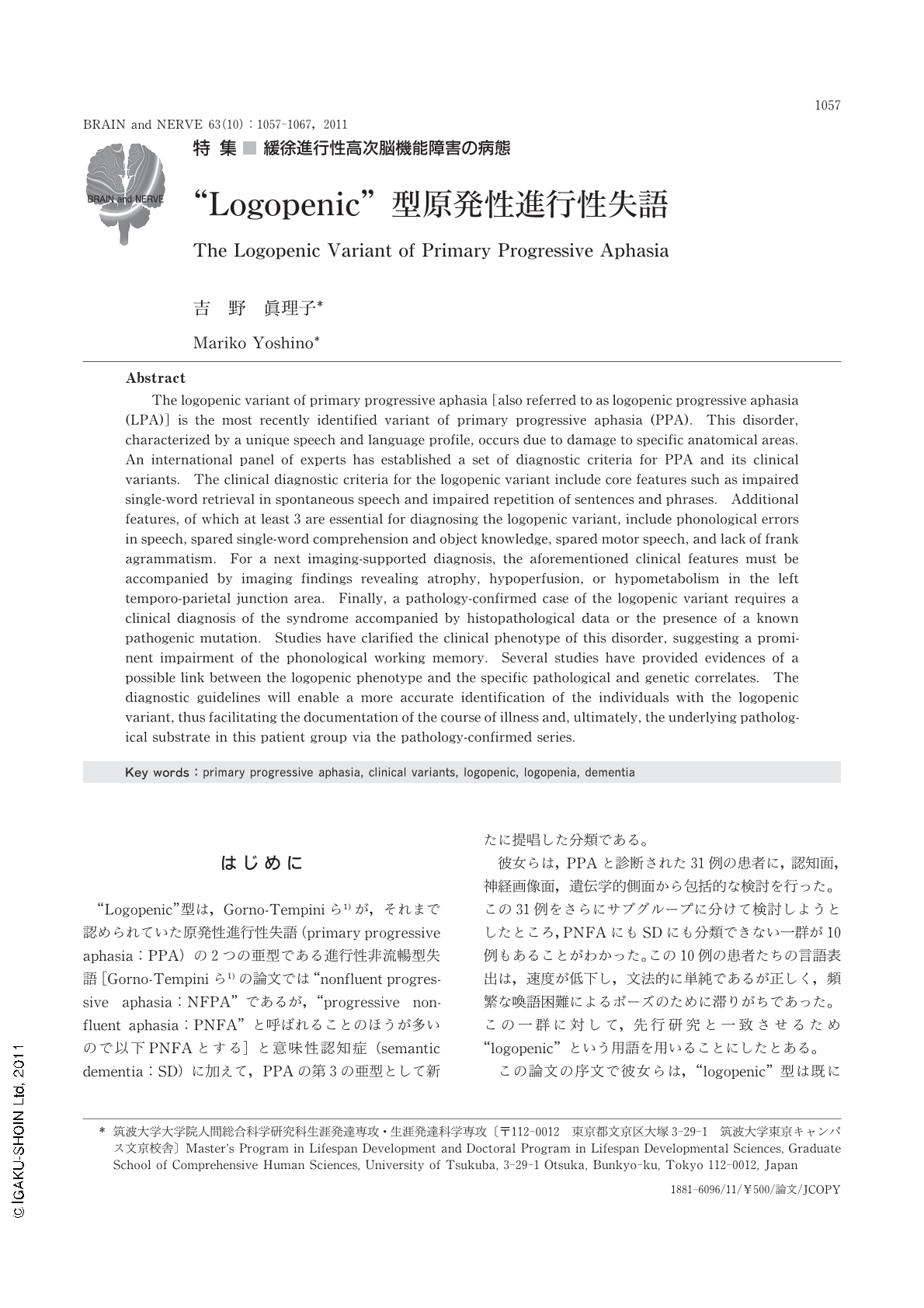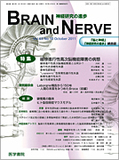Japanese
English
- 有料閲覧
- Abstract 文献概要
- 1ページ目 Look Inside
- 参考文献 Reference
はじめに
“Logopenic”型は,Gorno-Tempiniら1)が,それまで認められていた原発性進行性失語(primary progressive aphasia:PPA)の2つの亜型である進行性非流暢型失語[Gorno-Tempiniら1)の論文では“nonfluent progressive aphasia:NFPA”であるが,“progressive nonfluent aphasia:PNFA”と呼ばれることのほうが多いので以下PNFAとする]と意味性認知症(semantic dementia:SD)に加えて,PPAの第3の亜型として新たに提唱した分類である。
彼女らは,PPAと診断された31例の患者に,認知面,神経画像面,遺伝学的側面から包括的な検討を行った。この31例をさらにサブグループに分けて検討しようとしたところ,PNFAにもSDにも分類できない一群が10例もあることがわかった。この10例の患者たちの言語表出は,速度が低下し,文法的に単純であるが正しく,頻繁な喚語困難によるポーズのために滞りがちであった。この一群に対して,先行研究と一致させるため“logopenic”という用語を用いることにしたとある。
この論文の序文で彼女らは,“logopenic”型は既にWeintraubら2),Kerteszら3)によって記述されており,喚語困難があり発話量が減っているが統語と音韻は比較的保たれているという特徴を述べている。しかしながら,Weintraubら2)の報告をあたってみると“logopenic”という用語はみあたらず,経時的検討を行った4例はいずれも非流暢型失語プロフィールを呈したとある。少なくとも症例1は“logopenic”型に近い臨床像を呈しているが,そのほかの3例はどちらかといえばPNFAに近いように思われる。
Kerteszら3)は“logopenic”という形容詞を用いてはいるものの,特定のタイプを記述するために用いているわけではなく,初期には流暢であったPPA患者が後期にはほとんどが“logopenic”かつ非流暢になると述べているとおり,症状の記述にこの用語を用いている。
ところで,この“logopenic”という耳慣れない命名はどこから来たのであろうか。かなり大きな英和辞典を繙いてみても“logopenic”や“logopenia”という項目はみあたらない。語源的には,“logo-”はギリシャ語の“lógos”由来で“言葉(word)”や“言語(speech)”の意の連結形,“-penia”はギリシャ語の“penía”由来で“~の不足,欠乏(deficiency of)”の意の名詞連結形である。“logopenic”を「発話遅延型」と訳す例もみられる4)が,「遅延」とは少々意味が異なるようである。
“Logopenic”とか“logopenia”という用語を,進行性失語の記述に初めに使ったのはMesulam5)で,有名な“slowly progressive aphasia without generalized dementia”の論文中である。なんとここで報告された6名中4名の患者に“logopenia”が認められたとある。“logopenia”を呈した4例についてMesulam5)は,「発話は“logopenic”で,遅く,努力性で,喚語のためのポーズが長く,錯語は稀であった」と記述している。明らかに「遅い」とは別の概念であることが窺われる。
彼はのちにこの論文を回顧して,“logopenia”は彼自身の新造語であり,「雑談や迂言では流暢な発話であるのに,正確にいわなければならないと喚語困難のために非流暢になる」というように,「典型的非流暢型失語にあるような失文法が認められない患者における,流暢性が変動する状態」を記述するために名づけたと述べている6)。彼はまた,脳卒中による失語分類の根幹をなす流暢-非流暢の区別は,PPA患者の分類には当てはまらないことがあることを示唆している。むろん脳卒中による流暢型失語にも,喚語困難のための見かけの非流暢性が観察されることはよく知られている。おそらくPPAにおける“logopenia”では,非流暢な印象がもっと強いのであろう。
語源に忠実に「発話欠乏」型と訳したほうが適切のように思えるが,本稿では原語のまま“logopenic”型として稿を進めることにする。
Abstract
The logopenic variant of primary progressive aphasia [also referred to as logopenic progressive aphasia (LPA)] is the most recently identified variant of primary progressive aphasia (PPA). This disorder,characterized by a unique speech and language profile,occurs due to damage to specific anatomical areas. An international panel of experts has established a set of diagnostic criteria for PPA and its clinical variants. The clinical diagnostic criteria for the logopenic variant include core features such as impaired single-word retrieval in spontaneous speech and impaired repetition of sentences and phrases. Additional features,of which at least 3 are essential for diagnosing the logopenic variant,include phonological errors in speech,spared single-word comprehension and object knowledge,spared motor speech,and lack of frank agrammatism. For a next imaging-supported diagnosis,the aforementioned clinical features must be accompanied by imaging findings revealing atrophy,hypoperfusion,or hypometabolism in the left temporo-parietal junction area. Finally,a pathology-confirmed case of the logopenic variant requires a clinical diagnosis of the syndrome accompanied by histopathological data or the presence of a known pathogenic mutation. Studies have clarified the clinical phenotype of this disorder,suggesting a prominent impairment of the phonological working memory. Several studies have provided evidences of a possible link between the logopenic phenotype and the specific pathological and genetic correlates. The diagnostic guidelines will enable a more accurate identification of the individuals with the logopenic variant,thus facilitating the documentation of the course of illness and,ultimately,the underlying pathological substrate in this patient group via the pathology-confirmed series.

Copyright © 2011, Igaku-Shoin Ltd. All rights reserved.


